Visiting the aboriginal people Himbas

What would be a tour through a foreign country without any contact to the local people? Of course, one wants to have some information about the inhabitants, specially if those people live in a way that is strange for us, with some exotic habits and customs.
In Namibia, this country in the south-west of Africa, a lot of different population groups, but none of them are so fascinating to us as the Himbas are.
The Himbas, the last Nomadic people of Namibia
The Kaoko country, a scant and unexplored landscape at the north-west of Namibia, is the home country of the Himbas. These Nomadic people are approximately still between 8000 up to 12000 humans and belong to the last people of Africa who live in a mainly original way. Unfortunately, this way of living gets increasingly lost also in this population, not least due to some unreasonable tourists and guides who give the Himabs some t-shirts, trousers, watches and other apparently useful things or change them for other stuff.
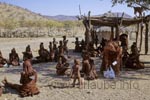
This is, undoubtfully, a wrong "developement aid". The culture of the Himbas is also highly jeopardized by the planned retaining dam at the waterfall of Epupa. This dam would not only destroy the waterfalls of Epupa, a former natural monument, but would also overflow the living space and the pasture of many Himba-Nomadic people. This would result in many of them moving to the slums of the city so that they would definitely lose their way of living and their culture. Surely, the arguments of those who support the building of the reatining dam are also considerable, as it would offer the country some electricity and a bigger water surface. It is hard to clearly judge about this, but the disadvantages of this dam seem to be more important.
What makes this conflict even more difficult is that for the goverment of Namibia, the Himbas are no dialogue partners. This is on one hand because they are considered as "semi-wilde people" by the Ovambos who mainly represent the government and on the other hand, there are still some resentments from the time of the bush war against the SWAPO. Thereby, the Himbas were caught between two fronts and finally fought for the South Africans who paid some high rewards for each killed SWAPO-fighter.

Visiting the Himbas is worthwhile in any case, as their way of living is exotic and amazing for the Europeans. But those who make such a tour with the eyes wide open and with nsome understanding for such kind of cultures will get some interesting insights and a lot of things to think about. Thereby, one should not miss to book such a guided tour or hire a guide. A knowledgeable guide knows where to find a kraal, generally knows the inhabitants and has their trust. These are all some important conditions for a satisfying tour for both parties and a way to get a lot of information of the way of living of the Himbas. These tours are offered by some lodges and statutorial institutions.
We followed a tip and made use of the offer of the toko-lodge which owner has a very good contact to the Himbas and can tell a lot of interesting things about them. But unfortunately, this tour is unreasonably expensive and due to the very long drive to there, there is not much time for the actual visit of the kraal. Those who plan such an excursion should better make use of one of the offers which starting point is in one of the villages of the proximity.
The closer we got to Opuwo, the main place of the Kaoko country, the more Himba women wearing their traditional costumes appeared at the roadsides. As it is many times the case in Namibia, Opuwo only consists on a few houses, a supermarket and some huts; We did not want to appear empty-handed at the Himbas so that we first buy some gifts. Specially bread, sugar, wheat, vaseline, exercise books, pencils and, of course, "sweetys" are very popular.
In the Himba-kraal
After some further 20 kilometres we arrive at our destination and drive to the kraal. We drive to one kraal to be more exactly, as several of them form a family union; Each kraal has about 5 to 10 inhabitants, whereby most of the times, there are only women and children. The men spend the most time with the cattle herds in the pasture, their most important posession. The news that we arrived is broadcasted like a wildfire, thus about 25 women and many children assemble to see the visitors and offer some souvenirs to them.
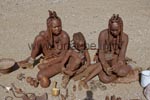
For us, it is a a fascinating view into a strangely appearing world. Despite of all differences, it appears likeable to us, not least due to the happy and open way of the Himbas. They have obviously fun by receiving the visitors and offer the souvenirs to them. But this always takes place in a very discreet way, without bargaining and putting us under pressure. Also when we bought some stuff from the neighbour, the others remained friendly and continued smiling at us.
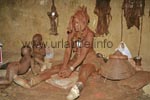
This is surely also due to the reason that we accept the Himbas just the way they are. We try never to be intrusive and kindly ask if we want to get something explained. Of course, we do not photograph before having asked for their consent. We proudly make use of our knowledge of their language that is limited to "Good afternoon, "Moro" in the Himba language.
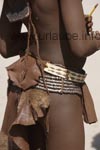
What is unimaginable for us Europeans is that the Himba women never do wash themselves. But those who think now on dirty and bad smelling people are wrong. The Himbas are very clean people and do not smell bad but maybe a little unusual for the sense of smell if the Europeans. This is due to the typical red paste that the women apply all over their bodies. It consists on a ferrous stone powder and originally buffalo grease, a thing that is increasingly replaced by vaseline. The regular appliance of it cleans the body and protects it additionally against a sunbrun and the drying of the skin. Due to the permanent handling with this paste, the whole household of the Himbas is covered with a red film. It does not take long until we also have some red spot on the clothes, hands and arms.

The Himbas also use some "deo sticks". Therefore, the branches of the "perfume bush" serve that give off an intensive smell by breaking them. By burning them, a pleasantly smelling smoke is generated over which the clothes, furs, ect. are hung and perfumed by this way.
The traditional clothing of the Himba women only consists on a loin cloth made of calfskin. They combine this with a lot of jewelry, necklaces, bracelets, anklets that are very artfully made. What is also very interesting is the outstanding hairstyle whereby some artificial hair is interlaced with the natural hair. In former times this was the hair of the animals, today it is mainly from the supermarket. In order not to destroy this laborious hairstyle, the women put their heads on a wooden stool for sleeping. The young girls wear two braids pointing to the front. They are supposed to symbolize the horns of the beefs, those animals that are so important to the Himbas. If the women wear a small adorned fur crown on their head, this means they are ready for getting married.
It is noticable that almost every young girl carries a baby with her and we are informed that the girls get their first baby with an average of 12 - 13 years. The gifts we brought them have made an effect and by this way we are invited to get into the interior of the hut, where the female boss of the clan shows us how to make the red paste and the grinding of corn wheat.
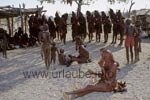
Of course we mainly want to make some pictures. Due to the reason we kindly ask for it, it is not a problem and after we shown the first images of the digital camera, we got more voluntary models than we actually needed. Specially the young mothers repeatedely picked our shirts and offered us their babies for the photos; As it is also the case in the rest of the world, mothers are always proud of their offspring.
The souvernirs offered are really original and interesting, also if they are not always traditional. The Himbas developed a lot of fantasy for making some artful bracelets, rings and a lot of other things from telephone cables, tubes and old shell bases. All things have a fixed price, there is no bargaining offered.
Time went by much too fast and we have to start our drive back. The women are asked to do their traditional dance to say good-bye to us. This dance consists on rapidly turning and jumping to some rhythmical clapping and calling. The trick is to control the twirling loin cloths so that nothing thereunder gets visible. The women dance with enthusiasm and get so in ecstasy that they forget everything around them. This continues until they are totally exhausted. Thus, we discretely leave and start our way back with some souvenirs in the luggage and specially with some remaining memories of a fascinating day with friendly and likeable people.

Back to the index Namibia
Author: Michael Nitzschke, Copyright: Patrick Wagner, www.tourist-guide.biz
|